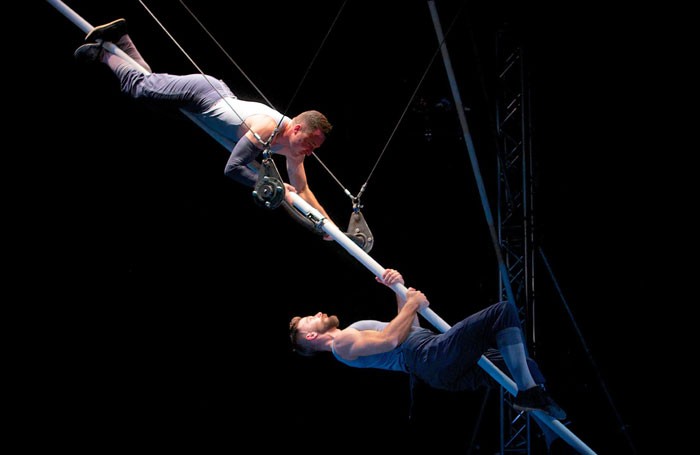If you thought Chinese Pole was pretty much the limit of what could be done in a circus with poles, then Tipping Point will prove you wrong. Created by British circus company Ockham’s Razor, founded by graduates of Circomedia, Academy of Circus Arts and Physical Performance in Bristol, and produced by Turtle Key Arts, Tipping Point is full of innovative uses for poles.
The performers begin by drawing a chalk circle around the stage from the end of one of the long poles in a reference to the traditional circus ring, as well as to Zen Buddhism, pagan magic, and Indian Mandalas. It also plays a practical purpose, as the performers use chalk to help with their grip on the poles, which appear in various configurations and numbers throughout the show – from two poles held by the performers for another to balance on, to five poles hanging from the rigging. These evoke various images, such as a pendulum or a forest, and offer some original ideas for circus equipment.
One gets the impression that Ockham’s Razor are aiming at a meditative tone. The performers are, for the most part, intent on what they’re doing, pausing little to acknowledge the audience. There are some points where they seem to consciously be trying to add some elements of fun: attempting to shake one performer off the poles, or guiding a performer with covered eyes through a maze of swinging poles, which help a little in balancing out the intensity of the performance. However, there is little deviation to the pace in Tipping Point, and while the instruments and mood of the music occasionally vary, the tempo remains much the same. Add to this the fact that all of the acts involve poles (leading to reappearances of the same tricks) and the show begins to feel a little repetitive after a while.
The performers are obviously very talented, and Tipping Point is in many ways an excellent demonstration of skill, strength, and balance. When it comes to its pacing, it has not quite achieved the right balance between meditative and gripping; and while the chalk makes for pretty pictures, releasing clouds of its dust into the air isn’t very friendly to asthmatic lungs.
